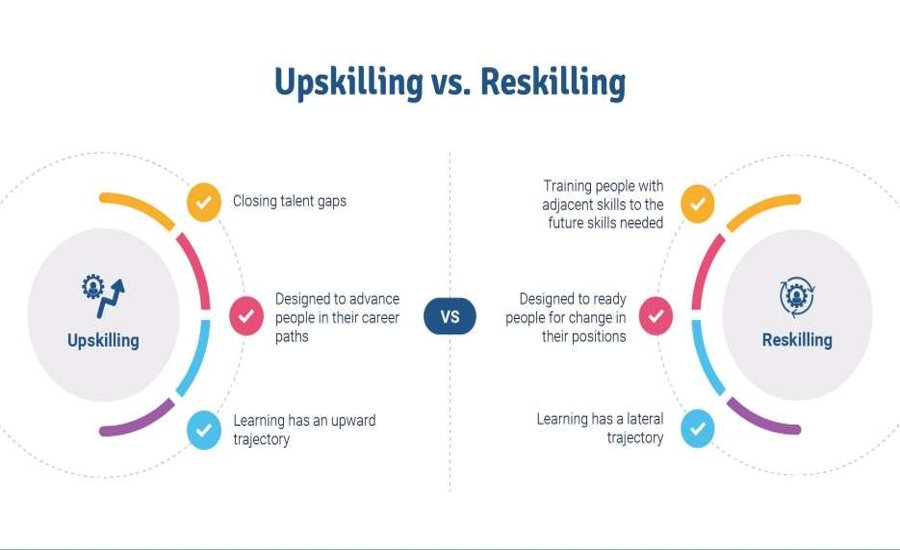In an era defined by rapid technological advancements, shifting market demands, and evolving job roles, reskilling and upskilling programs have become critical for organizational success and workforce sustainability. These programs are not just an investment in employee development—they are a strategic necessity for navigating the future of work.

-
Addressing the Skills Gap
The world is experiencing a widening skills gap that threatens economic growth and workforce stability. According to the World Economic Forum’s Future of Jobs Report (2023), 44% of workers’ skills will require updating within the next five years due to technological disruption. Organizations that implement structured reskilling and upskilling programs are better positioned to close these gaps, ensuring their workforce remains competitive and capable of meeting future demands.
Example: Amazon’s $1.2 billion Upskilling 2025 initiative aims to provide training to 300,000 employees to transition into high-demand roles like data analysts, cloud architects, and cybersecurity specialists. This demonstrates how reskilling programs can prepare organizations to address emerging challenges while empowering employees with new career opportunities.
-
Enhancing Employee Retention and Engagement
Investing in employee development fosters loyalty and engagement. A survey by LinkedIn’s Workplace Learning Report (2022) found that 94% of employees would stay longer at a company that invests in their career development. By demonstrating a commitment to employee growth, organizations can reduce turnover costs and create a culture of continuous learning.
Example: AT&T’s Future Ready Initiative retrained over 200,000 employees, reducing turnover and boosting employee satisfaction by preparing workers for emerging tech roles in software development and data analysis.
-
Boosting Organizational Agility
Organizations with well-trained, adaptable workforces can pivot quickly in response to market changes. Reskilling programs enable employees to transition into roles that align with shifting business needs, ensuring that companies can maintain productivity and innovation during disruption.
Stat:
Research by McKinsey & Company (2022) highlights that organizations with effective reskilling strategies are 63% more likely to fill skill gaps internally, reducing dependency on external hiring.
-
Driving Innovation and Competitiveness
Upskilling programs empower employees with the latest knowledge and tools, fostering innovation and improving operational efficiency. Employees with enhanced skills are more likely to contribute creative solutions and adopt advanced technologies, giving organizations a competitive edge.
Example: PwC’s Digital Fitness App, launched to upskill its workforce in digital technologies, has been instrumental in boosting employee productivity and driving innovative solutions for clients.
-
Supporting Diversity, Equity, and Inclusion (DEI)
Reskilling initiatives can promote inclusivity by providing underrepresented groups with access to new opportunities. Programs that focus on bridging skills gaps for women, minorities, and individuals from disadvantaged backgrounds help create a more equitable workforce.
Stat:
According to Deloitte, companies that prioritize reskilling for DEI see a 20% increase in employee representation in high-growth roles.
-
Long-Term Financial Benefits
While reskilling and upskilling require upfront investment, the long-term financial benefits far outweigh the costs. Companies can save significantly on recruitment expenses, reduce reliance on contingent labor, and minimize productivity losses due to unfilled positions.
Stat:
A Bersin by Deloitte study found that organizations that invest in employee development experience a 4.6x higher return on investment compared to companies that don’t.
Key Components of Successful Reskilling and Upskilling Programs
-
Personalized Learning Paths:
Tailor training to individual career goals and organizational needs to ensure relevance and impact.
-
Technology Integration:
Leverage e-learning platforms, AI-driven tools, and virtual reality for immersive and flexible learning experiences.
-
Cross-Functional Opportunities:
Encourage employees to gain skills outside their immediate roles, enabling greater internal mobility.
-
Continuous Feedback and Metrics:
Regularly measure the effectiveness of programs through employee feedback, performance data, and key business outcomes.
At The Talent Accelerator, we have taken the responsibility to develop market leading reskilling and upskilling learning programs in the areas of Total Rewards, HR Analytics, Employer Branding, Recruitment and Performance Management.
Conclusion: Preparing for the Future of Work
Reskilling and upskilling are no longer optional—they are essential strategies for organizations to thrive in an unpredictable and fast-paced world. By investing in these programs, companies can bridge the skills gap, improve retention, and enhance organizational resilience. At the same time, employees gain access to fulfilling career opportunities, ensuring mutual growth and success.
In a world where change is the only constant, organizations that prioritize learning and adaptability will be the ones to lead the charge into the future.

